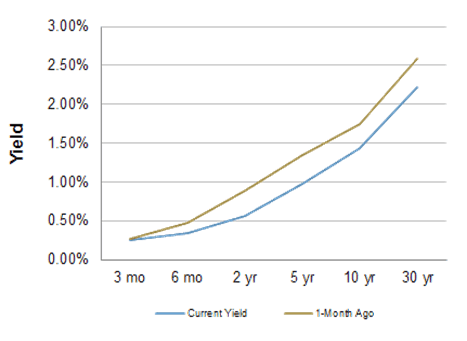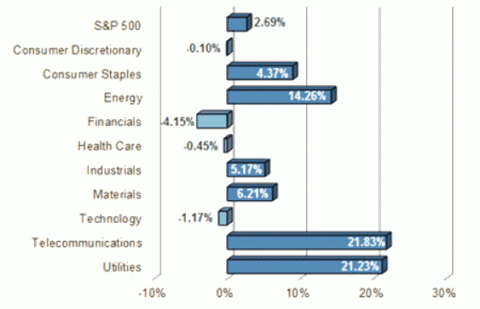 Clarksville, TN – Despite there being no plan for Brexit and expectations of a lengthy and uncertain process of disentanglement from the European Union, stock market fear subsided.
Clarksville, TN – Despite there being no plan for Brexit and expectations of a lengthy and uncertain process of disentanglement from the European Union, stock market fear subsided.
The impact on the U.S. economy of a weaker U.K. is expected to be small, and in some ways may even be positive (lower mortgage rates and greater capital flows to the U.S.). Long-term interest rates remain low.
Bank of England Governor Carney helped things along by suggesting that a rate cut would likely be warranted this summer (the BoE’s Monetary Policy Committee will meet on July 14th).

Real GDP rose at a 1.1% annual rate in the 3rd estimate of 1Q16 GDP growth, as anticipated, but the mix was unexpected (consumer spending was revised lower, exports flipped from a moderate negative to a small positive, and business fixed investment fell less steeply).
The markets rarely give much attention to the personal income and spending data, but the May figures showed that inflation-adjusted consumer spending (70% of GDP) is on track for an annual rate of 4.0-4.5% in 2Q16 (vs. +1.5% in 1Q16). One important caveat: annual benchmark revisions to these data are due on July 29th.
Next week, the focus will be on the July Employment Report. Payrolls were surprisingly soft in May (with a downward revision to March and April), even accounting for 35,000 striking Verizon workers. Those strikers will return in the June payroll data.
Why has job growth slowed into 2Q16? Mild weather may have pulled forward seasonal job gains into earlier months. It could be statistical noise or problems with seasonal adjustment. Firms may have slowed their hiring (job destruction still appears to be low), or firms may be having a tougher time finding qualified workers as the job market tightens. Or it could be a combination of all of these.
Hopefully, the June job market data will help to answer the question, but we ought to see a moderate pace of payroll growth in June. Still, seasonal adjustment (the end of the school year) may add some noise. Whatever the case, financial market participants will look to the payroll figure to help set expectations for the economy and monetary policy.
Indices
| Last | Last Week | YTD return % | |
| DJIA | 17929.99 | 18011.07 | 2.90% |
| NASDAQ | 4842.67 | 4910.04 | -3.29% |
| S&P 500 | 2098.86 | 2113.32 | 2.69% |
| MSCI EAFE | 1608.45 | 1687.04 | -6.28% |
| Russell 2000 | 1151.92 | 1172.22 | 1.41% |
Consumer Money Rates
| Last | 1 year ago | |
| Prime Rate | 3.50 | 3.25 |
| Fed Funds | 0.41 | 0.13 |
| 30-year mortgage | 3.42 | 4.08 |
Currencies
| Last | 1 year ago | |
| Dollars per British Pound | 1.331 | 1.562 |
| Dollars per Euro | 1.111 | 1.153 |
| Japanese Yen per Dollar | 103.20 | 123.17 |
| Canadian Dollars per Dollar | 1.292 | 1.259 |
| Mexican Peso per Dollar | 18.280 | 15.778 |
Commodities
| Last | 1 year ago | |
| Crude Oil | 48.33 | 56.96 |
| Gold | 1320.60 | 1169.30 |
Bond Rates
| Last | 1 month ago | |
| 2-year treasury | 0.56 | 0.88 |
| 10-year treasury | 1.43 | 1.79 |
| 10-year municipal (TEY) | 2.09 | 2.51 |
Treasury Yield Curve – 07/01/2016
As of close of business 06/30/2016
S&P Sector Performance (YTD) – 07/01/2016
As of close of business 06/30/2016
Economic Calendar
| July 4 | — | Independence Day Holiday (markets closed) |
| July 6 | — | ISM Non-Manufacturing Index (June) FOMC Minutes (June 14-15) |
| July 7 | — | ADP Payroll Estimate (June) Jobless Claims (week ending July 2) |
| July 8 | — | Employment Report (June) |
| July 13 | — | Fed Beige Book |
| July 14 | — | BOE Policy Decision |
Important Disclosures
US government bonds and treasury bills are guaranteed by the US government and, if held to maturity, offer a fixed rate of return and guaranteed principal value. US government bonds are issued and guaranteed as to the timely payment of principal and interest by the federal government. Treasury bills are certificates reflecting short-term (less than one year) obligations of the US government.
Commodities trading is generally considered speculative because of the significant potential for investment loss. Markets for commodities are likely to be volatile and there may be sharp price fluctuations even during periods when prices overall are rising. Specific sector investing can be subject to different and greater risks than more diversified investments.
Tax Equiv Muni yields (TEY) assume a 35% tax rate on triple-A rated, tax-exempt insured revenue bonds.
![]() Material prepared by Raymond James for use by its financial advisors.
Material prepared by Raymond James for use by its financial advisors.
The information contained herein has been obtained from sources considered reliable, but we do not guarantee that the foregoing material is accurate or complete. Data source: Bloomberg, as of close of business June 30th, 2016.





